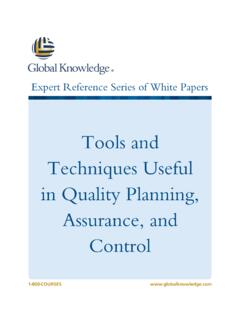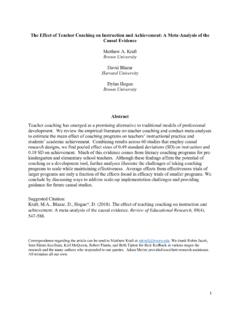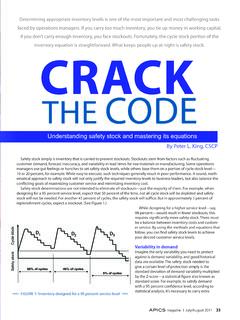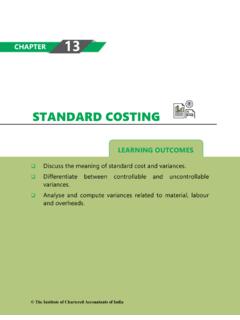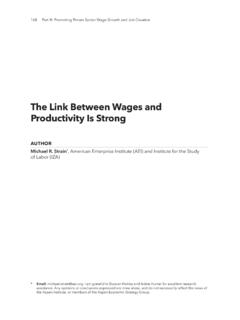Transcription of Analyzing Likert Data - The Journal of Extension (JOE)
1 Analyzing Likert [8/20/2012 9:07:48 AM]April 2012 Volume 50 Number 2 Article Number 2 TOT2 Return to Current IssueAnalyzing Likert DataHarry N. Boone, A. BooneAssociate Virginia UniversityMorgantown, West VirginiaAbstract: This article provides information for Extension professionals on the correct analysis ofLikert data . The analyses of Likert -type and Likert scale data require unique data analysisprocedures, and as a result, misuses and/or mistakes often occur. This article discusses thedifferences between Likert -type and Likert scale data and provides recommendations fordescriptive statistics to be used during the analysis .
2 Once a researcher understands the differencebetween Likert -type and Likert scale data , the decision on appropriate statistical procedures willbe the years, numerous methods have been used to measure character and personality traits( Likert , 1932). The difficulty of measuring attitudes, character, and personality traits lies in theprocedure for transferring these qualities into a quantitative measure for data analysis recent popularity of qualitative research techniques has relieved some of the burdenassociated with the dilemma; however, many social scientists still rely on quantitative measuresof attitudes, character and personality response to the difficulty of measuring character and personality traits, Likert (1932)developed a procedure for measuring attitudinal scales.
3 The original Likert scale used a series ofquestions with five response alternatives: strongly approve (1), approve (2), undecided (3),disapprove (4), and strongly disapprove (5). He combined the responses from the series ofquestions to create an attitudinal measurement scale. His data analysis was based on thecomposite score from the series of questions that represented the attitudinal scale. He did notanalyze individual questions. While Likert used a five-point scale, other variations of his responsealternatives are appropriate, including the deletion of the neutral response (Clason & Dormody,1994).
4 Likert response alternatives are widely used by Extension professionals. By the time of thisarticle's preparation, at least 12 articles published in the 2011 Journal of Extension had usedsome form of a Likert response. In 2010, at least 21 articles published in the Journal ofExtension used the technique. The articles published in 2011 included 4-point Likert alternatives(Behnke & Kelly, 2011; Robinson & Shepard, 2011), five-point Likert alternatives (Diker,Walters, Cunningham-Sabo, & Baker, 2011; Elizer, 2011; Hines, Hansen, & Falen, 2011;Kalambokidia, 2011; Kroth & Peutz, 2011; Singletary, Emm, & Hill, 2011), six-point Likertalternatives (Allen, Varner, & Sallee, 2011; Beaudreault & Miller, 2011; Wyman et al.)
5 , 2011),and a seven-point Likert alternative (Walker, Vaught, Walker, & Nusz, 2011).While variations of the Likert response alternative have become common in Extension research,common usage has also created misuses or mistakes. One mistake commonly made is theimproper analysis of individual questions on an attitudinal scale. Before we discuss the analysisAnalyzing Likert [8/20/2012 9:07:48 AM]of Likert data , let's review the basic concepts of the Versus Likert ScalesClason and Dormody (1994) described the difference between Likert -type items and Likertscales.
6 They identified Likert -type items as single questions that use some aspect of the originalLikert response alternatives. While multiple questions may be used in a research instrument,there is no attempt by the researcher to combine the responses from the items into a compositescale. Table 1 provides an example of five Likert -type Likert -Type Questions StronglyDisagreeDisagreeNeutralAgreeStro nglyAgree1. 4-H has been a goodexperience for My parents haveprovided support for my4-H My 4-H involvementwill allow me to make My 4-H advisor wasalways there for Collegiate 4-H isimportant in theselection of a Likert scale, on the other hand, is composed of a series of four or more Likert -type items thatare combined into a single composite score/variable during the data analysis process.
7 Combined,the items are used to provide a quantitative measure of a character or personality the researcher is only interested in the composite score that represents thecharacter/personality trait. Table 2 provides an example of five questions designed to becombined into a Likert scale measuring eating Likert Questions Designed to Create a "Healthy Eating" Likert Scale StronglyDisagreeDisagreeNeutralAgreeStro nglyAgree1. I eat healthy foodson a regular When I purchase foodat the grocery store, Iignore "junk" When preparingmeals, I consider the fatcontent of food When preparingmeals, I consider thesugar content of Likert [8/20/2012 9:07:48 AM]5.
8 A healthy diet isimportant to my 's Scale of MeasurementBoth Likert -type and Likert scale data have unique data analysis procedures. To understand theoptions, one must start with the Steven's Scale of Measurement (Ary, Jacobs, & Sorenson,2010). The Steven's scale consists of four categories: nominal, ordinal, interval, and the nominal scale, observations are assigned to categories based on equivalence. Numbersassociated with the categories serve only as labels. Examples of nominal scale data includegender, eye color, and race. Ordinal scale observations are ranked in some measure ofmagnitude.
9 Numbers assigned to groups express a "greater than" relationship; however, howmuch greater is not implied. The numbers only indicate the order. Examples of ordinal scalemeasures include letter grades, rankings, and achievement (low, medium, high). Interval scaledata also use numbers to indicate order and reflect a meaningful relative distance betweenpoints on the scale. Interval scales do not have an absolute zero. An example of an intervalscale is the IQ standardized test. A ratio scale also uses numbers to indicate order and reflects ameaningful relative distance between points on the scale.
10 A ratio scale does have an absolutezero. Examples of ratio measures include age and years of Likert Response ItemsTo properly analyze Likert data , one must understand the measurement scale represented byeach. Numbers assigned to Likert -type items express a "greater than" relationship; however,how much greater is not implied. Because of these conditions, Likert -type items fall into theordinal measurement scale. Descriptive statistics recommended for ordinal measurement scaleitems include a mode or median for central tendency and frequencies for variability.

